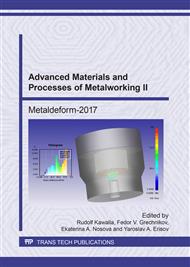[1]
A. Kumar, Experimental Investigations with Crush Box Simulations for Different Segment Cars using LS-DYNA, International Journal of Current Engineering and Technology 2 (2013) 670–676.
DOI: 10.14741/ijcet/spl.2.2014.127
Google Scholar
[2]
S. Sharma, Sandwich steels for crash energy absorption applications, PhD thesis, University of Warwick, UK, (2014).
Google Scholar
[3]
I. Burchitz, R. Boesenkool, et al., Highlights of designing with Hylite – a new material concept , Materials & Design 26 (2005) 271–279.
DOI: 10.1016/j.matdes.2004.06.021
Google Scholar
[4]
ThyssenKrupp Steel Europe, Leichtes Sandwich. Umformtechnik. Net (Hrsg. ). Verlag Maisenbach. http: /www. umformtechnik. net/leichtes-sandwich_27262_de.
Google Scholar
[5]
S. E. Stapleton, D. O. Adams, Crush Initiators for Increased Energy Absorption in Composite Sandwich Structures, Journal of Sandwich Structures and Materials 10 (2008) 331–354.
DOI: 10.1177/1099636208091737
Google Scholar
[6]
N. Jones, Structural impact, 2nd ed. Cambridge University Press, New York, (2012).
Google Scholar
[7]
M. D. White, N. Jones, Experimental quasi-static axial crushing of top-hat and double-hat thin-walled sections, International Journal of Mechanical Sciences 41 (1999) 179–208.
DOI: 10.1016/s0020-7403(98)00047-2
Google Scholar
[8]
M. D. White, N. Jones, Experimental study into the energy absorbing characteristics of top-hat and double-hat sections subjected to dynamic axial crushing, Proceedings of the Institution of Mechanical Engineers, Part D: Journal of Automobile Engineering 213 (1999).
DOI: 10.1243/0954407991526856
Google Scholar
[9]
G. Lu, T. X. Yu, Energy absorption of structures and materials, CRC Press; Woodhead Pub. Ltd, Boca Raton, Cambridge England, (2003).
Google Scholar
[10]
Reuter, C. Bartelt, P., Analysis of the Energy Absorption of Axial -loaded Metal-CFRP-Hybrid Components, Euro Hybride 2016, Kaisersslautern, Germany.
Google Scholar
[11]
A. G. Mamalis, D. E. Manolakos, et al., The effect of the implementation of circular holes as crush initiators to the crushing characteristics of mild steel square tubes: Experimental and numerical simulation, International Journal of Crashworthiness 14 (2009).
DOI: 10.1080/13588260902826547
Google Scholar
[12]
Y. -B. Cho, C. -H. Bae, et al. , A vehicle front frame crash design optimization using hole-type and dent-type crush initiator, Thin-Walled Structures 44 (2006) 415–428.
DOI: 10.1016/j.tws.2006.03.011
Google Scholar
[13]
M. W. Joosten, S. Dutton, et al. , Experimental evaluation of the crush energy absorption of triggered composite sandwich panels under quasi-static edgewise compressive loading, Composites Part A: Applied Science and Manufacturing 41 (2010).
DOI: 10.1016/j.compositesa.2010.03.010
Google Scholar
[14]
O. Sokolova, Study of metal/polymer/metal hybrid sandwich composites for the automotive industry, 1. Aufl. Papierflieger, Clausthal-Zellerfeld, (2013).
Google Scholar
[15]
A. Carradò, J. Faerber, et al., Metal/polymer/metal hybrid systems: Towards potential formability applications, Composite Structures 93 (2011) 715–721.
DOI: 10.1016/j.compstruct.2010.07.016
Google Scholar
[16]
A. Carradò, O. Sokolova, B. Donnio, H. Palkowski, Influence of corona treatment on adhesion and mechanical properties in metal/polymer/metal systems, Journal of Applied Polymer Science. 120 (2011) 3709–3715.
DOI: 10.1002/app.33583
Google Scholar
[17]
A. Elmarakbi, Advanced Composite Materials for Automotive Applications, John Wiley & Sons Ltd, Chichester, UK, (2013).
Google Scholar


